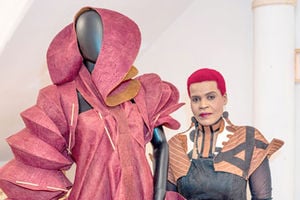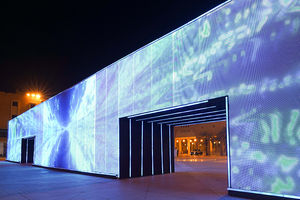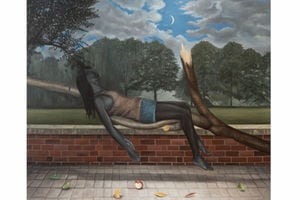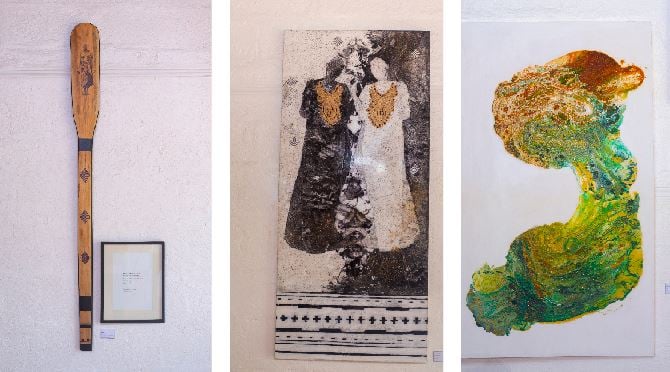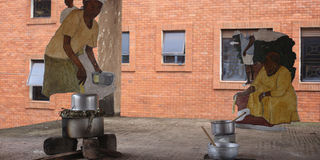
Mwesigwa says food plays a big role in family gatherings. In his installations, he puts together a painting with real kitchen ware. PHOTO/Andrew Kaggwa
Art is a public good; of course, there is a lot of art that is purchased by private individuals or is kept in private galleries. But there is more art that exists as a public good. Think about the monuments, architecture, and murals across major cities.
And this is where K’la Art comes into the picture. The K’la Art Festival has over the years given exhibition and visual art a twist; to say it right, the exhibition always turns visual art exhibition on its head.
The bi-annual festival takes art away from art galleries, museums, and institutions to the city. Thus, the city, streets, decapitated buildings, play fields, and landing sites become the gallery.
The festival has, for past editions since 2012 exhibited a wide range of artists from multiple visual art disciplines such as sculpture, painting, and installation, among others.
By bringing art closer to communities, conversations are generated, and locals are given a chance to interpret the artist’s work in ways they understand it. For instance, in 2014, many stopped to look at Hellen Nabukenya’s multicoloured weave installation on the Uganda Railways offices; regardless of their independent interpretation of the work, ridiculous or outrageous, they had engaged with work they may not have engaged with had it been in a gallery.
However, over the years, collaborations have been hatched, which in turn has introduced performance disciplines such as music, drama, and poetry.
Aptly titled Care Instructions, this year’s edition is thinking about cultural heritage in Uganda as a series of instructions that we have received on how we might live well.
The fifth edition kicked off on August 8. It opened at Ganzu, an incomplete construction site on Lumumba Avenue.
The opening captured different aesthetics of the festival that include performance, sculpture, painting, and food.
At Ganzu, much as there were performances by Nilotika Cultural Essemble, it was about everything, such as food, games, and the art.
Two artists, Catherine Lie and Brogan Mwesigwa have their work at the space. Catherine is a designer, researcher, and author of the upcoming book Sourdough Architecture. Sourdough Architecture explores how the everyday knowledge of feeding and baking sourdough could open up discussions on design and ecology to other experts and a broader public, necessary to address contemporary challenges.
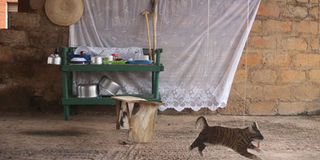
Sourdough is a specific type of bread created through a natural fermentation process involving suitable bacteria and wild yeasts in the environment and, most importantly, on the grain itself.
Like this year’s theme, Care Instructions, sourdough is a practise Catherine is protecting and passing on, she says that some families pass on sourdough they have maintained for nearly 20 years. Sourdough has been around for generations, though during Covid-19, with the scarcity of yeast, there was an increased interest in sourdough since it’s entirely done at home.
Catherine is making souredough at different spots of the festival, introducing the culture to Ugandans.
In the same space at Ganzu, Mwesigwa has his installation, Kumanyagana. This is a continuation of his event of the same name at 32 Degrees early this year. The focus of the installation is to relive the times when people come together. However, what Mwesigwa does is that he puts his installation in this incomplete building, which also doubles as a makeshift restaurant for many of the people that work on this street.
Mwesigwa puts together an installation that depicts a get together and a couple of activities that take place during such events. He captures the aesthetics, the mood with the surroundings; from one side, his installation is using the city as a backdrop, but from another angle, he had created a fully functional village home kitchen that, on the opening day, some people even sat waiting to be served.
Mwesigwa made his works out of recycled paper, which he attaches to a net and holds together using bits of cement. He says the reason for using a net and cement was to mimic the environment he’s showcasing, an incomplete building.
Besides Ganzu however, the festival is also taking place at the Ggaba Landing site, a venue many artists have loved having installations at, Kamwokya Tresor Life Centre, where Sixte Kakinda has his work Katasumbika.
According to the festival statement, Katasumbika is a process of reflection on what cannot be detached or torn away from a human. In particular, the relationship between humans and the land or culture represented here by the banana tree which plays, for the Nande and Konzo, a vital role in the preservation of their traditions.
The title of the work is from the Nande tribe but has a Luganda wordplay to it which means not to disturb.
The K’la Art Festival is going on until August 24.
